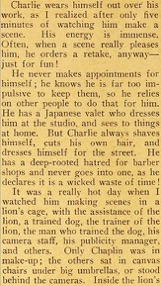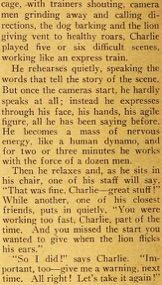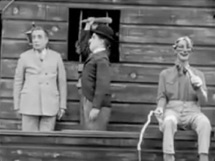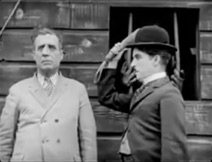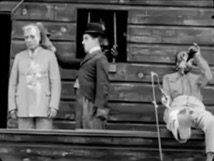The Circus 1927 1928 1929 next previous
The Circus Clippings 116/376
Margaret Chute, Picture-Play, New York, February 1927.
The Circus Scenes
& MRS. CHAPLIN CAN‘T COLLECT ON COAST
Subpoena Schenck and Goldwyn – Gov‘t Now Into
Comedian for $3,000,000 (...)
That little mess between Charlie Chaplin and his wife
became more and more tangled last week than
it has ever been. The result is that Mrs. Chaplin will not
be able to collect the $14,000 alimony and counsel
for fee granted her by Superior Court Judge Guerin, which
was to be deducted from from $74,000 cash assets
the comedian had. (...)
With Chaplin deciding to finish „The Circus“ in New York,
preparations are being made at the local studio
to ship props and other production accessories east at the
time Myrna Kennedy, Harry Crocker, Henry Bergman
and other principals leave to join the comedian. It is expected
a start will be made this week. It will take two baggage
cars to handle the entire production outfit, with the transportation
cost estimated at around $15,000.
The government found another lien lying loose
with the result they now have $3,000,000 in plasters on the
Chaplin assets.
(...) Variety, Feb. 2, 1927
„He expresses through his face, his hands, his agile figure“
Editorial content. „Two Dreams Come True
Charlie Chaplin at last films his long-cherished tale
of a circus clown, and in the course of the
production an envoy from home, an English journalist,
visits the studio and at last meets her idol.
She tells in the story below her impressions of her
famous fellow countryman at work.
By Margaret Chute
IT was the blazer that attracted my attention first
of all. Within the circus tent, on the orderly studio
lot nestling between Sunset Boulevard and La Brea Avenue,
all was dim, cool, and shady; and from the surrounding
neutral tones that blazer sprang to my sight like a burst of
fireworks.
He who was wearing it, a slender little man with a shock
of curly hair, stood with his back to me, talking
to an electrician. So for several minutes I enjoyed the full
radiance of that orange-and-royal-blue-striped
blazer. Then its wearer turned, and I met Charlie Chaplin
for the first time.
At the sound of his voice, low and crisp, with
an unmistakable not of London in it, I wanted to hug him;
he represented ,home‘ to me – six thousand
miles away. Simultaneously, like a couple of vaudeville
patter performers, we exclaimed: ,It‘s good to hear
a London voice!‘ Whereat we both laughed.“ (...)
„Between that day and the afternoon when I saw him
at work with the lions, I found out one or two
special characteristics of this strange, emotional man.
For instance, Charlie loves to spring surprises
on his studio staff. He has three dressing rooms – one
at home, two at the studio. Sometimes, when
he is not expected to work, he arrives early in the morning,
fully made up, and chuckles like a child because
he has fooled the staff!
To them all he is known as ,He‘ or ,Charlie.‘ Each morning
the staff await his arrival. As the car drives in, his
camera man, Roland Totheroh, always called ,Rollie,‘ lets
out a yell – ,He‘s here!‘ Then every one charges
into the projection room, along with Charlie, to see the
,rushes‘ of the previous day‘s work. Sometimes
he is elated at what he sees; sometimes he gets mad, and
may change whole sequences.“ (...)
„Charlie wears himself out over his work, as I realized
after only five minutes of watching him making
a scene. His energy is immense. Often, when a scene
really pleases him, he orders a retake, anyway
– just for fun!“ (...)
„It was a really hot day when I watched him making
scenes in a lion‘s cage, with the assistance
of the lion, a trained dog, the trainer of the lion, the man
who trained the dog, his camera staff, his publicity
manager, and others. Only Chaplin was in make-up; the others
sat in canvas chairs under big umbrellas, or stood
behind the cameras. Inside the lion‘s cage, with trainers
shouting, camera men grinding away and calling
directions, the dog barking and the lion giving vent to healthy
roars, Charlie played five or six difficult scenes,
working like an express train.
He rehearses quietly, speaking the words that tell
the story of the scene. But once the cameras
start, he hardly speaks at all; instead he expresses through
his face, his hands, his agile figure, all he has been
saying before. He becomes a mass of nervous energy,
like a human dynamo, and for two or three minutes
he works with the force of a dozen men.“ (...)
Three photos.
Redaktioneller Inhalt
The Circus 1927 1928 1929 next previous

